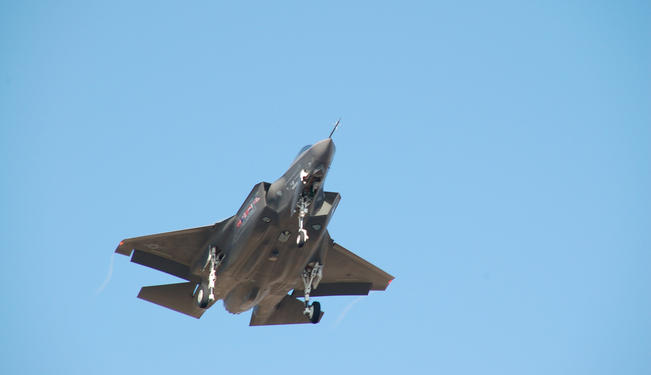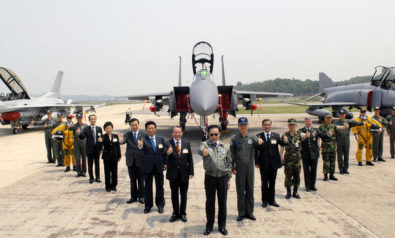It is questionable whether using simulators to test fighter jets will be sufficient to decide which ones South Korea's military will acquire. Moreover, the expected expenditure for the procurement project has to be recalculated.
South Korea’s Ministry of National Defense (MND) is stirring into the third phase of the ambitious plan to acquire new multi-role strike aircraft. The decision over which fighter jets shall replace the aging F-4 Phantom II and F-5E fighter aircraft could be made as early as October 2012.
The contenders are the Boeing’s F-15SE Silent Eagle, the Eurofighter Typhoon of the European Aeronautic Defense and Space (EADS), and the Lockheed Martin F-35 Lightning II Joint Strike Fighter. The move to update South Korea’s airpower has been met with mixed feelings. Without a doubt, the Republic of Korea’s (ROK) aging fighter jets need to be decommissioned soon. However, criticism has been voiced with regards to the procurement project: the hasty tempo and miscalculated expenditure of the project, to name two. It is not too late to reexamine the entire process. By doing so, the government and military may avoid another politico-military procurement scandal.
The Controversy
According to a recent news report in South Korea, the Defense Acquisition Program Administration has decided that a simulator will replace the F-35 onsite test-flying. The reason behind this decision is that the F-35 is in the middle of development and improvement processes. More importantly, the US government will not allow a foreign country to test-fly the fighter jet due to the technological sensitivities. The Boeing’s F-15SE and EADS’ Eurofighter Typhoon will also be tested using the simulators due to their own development and improvement processes.
The question at hand is whether using simulators for all three fighters will be effective and accurate enough for the final selection. Considering the estimated amount of US$7.1bn which will be spent, critics in South Korea have increasingly questioned the entire procurement project.
The categories that will be tested are the F-35’s air-to-air and air-to-surface attack capabilities, the F-15SE’s internal weapons bay, radar cross-section reduction and protection mechanism, and the Eurofighter Typhoon’s Active Electronically Scanned Array radar, protection mechanisms, air-to-air and air-to-surface attack capabilities. Given the categories that will be tested, it is no wonder that many critics argue against the entire procurement program, or ask for a slowdown of the procurement process.
The evaluations and tests will be conducted from July to October, 2012. Especially in comparison to the previous F-X I and F-X II phases, critics have strongly contended that the duration is insufficient for the evaluation of all three bidding companies. Above all, the entire time of the procurement project will be insufficient for the South Korean government to secure the best possible price and terms from the competing companies.
Seoul's Miscalculations
As testing methods and the duration are being questioned, there is another issue that also needs to be examined. On June 15, Norway, which contributed to the development costs of the Lockheed Martin F-35 Lightning II program, had authorized its orders for 52 F-35A fighters. The estimated cost for Norway to procure the fighter jets was reported to be about US$10bn. South Korea, on the other hand, did not participate in shouldering the development and production costs. The estimated amount to purchase a fleet of about 60 next-generation fighter jets for South Korea is about US$7.1bn. It is not hard to notice the huge miscalculation in Seoul’s procurement project.
The government in Seoul has consistently denied that there is a favorite fighter jet; in case Lockheed Martin’s F-35A will be announced as the winner, the country will most likely spend more money than it planned.
The Next Steps
Without question, the Republic of Korea Air Force (ROKAF) has to modernize and upgrade its aging fleet. Given the turbulent strategic nature of the two Koreas, Northeast Asia and Asia-Pacific as a whole, the modernization program of the ROKAF must be carried out. Even though critics have expressed their doubts about the speedy process of the procurement project and the unrealistic calculation of the expenditure, they have not challenged the need for modernizing the fleet of the ROKAF fighter jets.
The F-X III program has become the largest defense procurement project of the Seoul government. Before the government makes its final selection, the Seoul government must answer the questions that critics have raised. Without it, the government and the South Korea’s military as a whole may face another politico-military debacle in near future.
The views expressed in this article are the author's own and do not necessarily reflect Fair Observer’s editorial policy.
Support Fair Observer
We rely on your support for our independence, diversity and quality.
For more than 10 years, Fair Observer has been free, fair and independent. No billionaire owns us, no advertisers control us. We are a reader-supported nonprofit. Unlike many other publications, we keep our content free for readers regardless of where they live or whether they can afford to pay. We have no paywalls and no ads.
In the post-truth era of fake news, echo chambers and filter bubbles, we publish a plurality of perspectives from around the world. Anyone can publish with us, but everyone goes through a rigorous editorial process. So, you get fact-checked, well-reasoned content instead of noise.
We publish 2,500+ voices from 90+ countries. We also conduct education and training programs
on subjects ranging from digital media and journalism to writing and critical thinking. This
doesn’t come cheap. Servers, editors, trainers and web developers cost
money.
Please consider supporting us on a regular basis as a recurring donor or a
sustaining member.
Will you support FO’s journalism?
We rely on your support for our independence, diversity and quality.





Comment